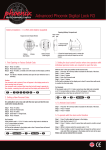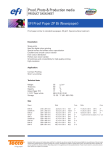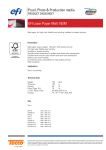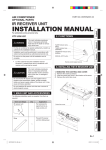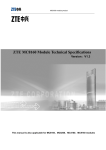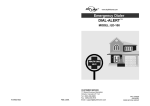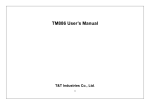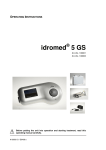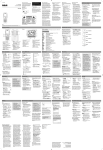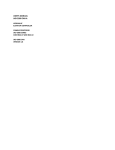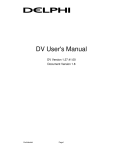Download Laser Ride Height System User Manual
Transcript
LRHS-1 LASER RIDE HEIGHT SYSTEM USER MANUAL Rev. C 7/ 24 / 2013 Copyright © 2013 Techmor, Inc. Overview The Techmor Laser Ride Height System consists of four wireless laser measurement units, a wireless bridge and 7” Android Tablet to view the output of each unit. Each unit can be attached to a corner of the car to measure vehicle height from the ground. Components (4) Wireless LASER Measurement Units with chargers (1) Wireless Bridge with charger (1) 7” Android Tablet with charger Turning the System On 1) Press the power button on each corner unit. 2) Press the power button on the Wireless Bridge. The orange status light will indicate a steady fast blink. Once a Bluetooth connection is established with the Tablet the status light will change its pattern. 3) Turn on the Tablet and start the Techmor Application. 4) Press the Connect button on the lower right corner of the screen. A dialog box will appear. Select TM_LRH to establish the connection to the Wireless Bridge. The screen should show a green “connected to TM_LRH”. Features Connect: Use this to select the appropriate bridge and initial Bluetooth connection Zero: The Zero button zeros the current measurement and shows a signed number, a positive value is farther distance, a negative value is a closer distance. Reset: Clears the zero-ed value and reverts to the absolute measurements. Copyright © 2013 Techmor, Inc. Using the Techmor App no conn: This indicates that corner unit is not communicating with the system. Check that the unit is on and there is nothing that is blocking the radio transmission. OOR: The measurement is out of range. lobatt: The corner unit battery voltage is below 3.3 volts and should be recharged. Bridge Unit Features Copyright © 2013 Techmor, Inc. Corner Unit Features Copyright © 2013 Techmor, Inc. Mechanical Dimensions DIMENSIONS ARE IN INCHES Copyright © 2013 Techmor, Inc. Mechanical Dimensions (CONT.) DIMENSIONS ARE IN INCHES Copyright © 2013 Techmor, Inc. Safety and Care Please see below for proper care and handling of the Li-ion batteries that are in each corner unit and wireless bridge of the Techmor Laser Ride Height System. WARNING: Please read before charging or using battery IMPORTANT SAFETY INSTRUCTIONS AND WARNINGS • You must read these safety instructions and warnings before using or charging your batteries. • Lithium Polymer and Li-ion batteries are volatile. Failure to read and follow the below instructions may result in fire, personal injury and damage to property if charged or used improperly. • Techmor Inc assumes no liability for failures to comply with these warnings and safety guidelines. • By purchasing Lithium Polymer and Li-ion battery, the buyer assumes all risks associated with lithium batteries. If you do not agree with these conditions, please consider NiMH or NiCd battery or return the battery immediately before use. General Guidelines and Warnings 1) Use specific Lithium Polymer/Li-ion charger only. Do not use a NiMH or NiCd charger Failure to do so may a cause fire, which may result in personal injury and property damage. 2) Never charge batteries unattended. When charging LiPo/Li-ion batteries you should always remain in constant observation to monitor the charging process and react to potential problems that may occur. 3) Some LiPo/Li-ion chargers on the market may have technical deficiencies that may cause it to charge the LiPo/Li-ion batteries incorrectly or at an improper rate. It is your responsibility solely to assure the charger you purchased works properly. Always monitor charging process to assure batteries are being charged properly. Failure to do so may result in fire. 4) If at any time you witness a battery starting to balloon, swell up, smoke or hot, discontinue charging process immediately, disconnect the battery and observe it in a safe place for approximately 15 minutes. This may cause the battery to leak, and the reaction with air may cause the chemicals to ignite, resulting in fire. 5) Since delayed chemical reaction can occur, it is best to observe the battery as a safety precaution. Battery observation should occur in a safe area outside of any building or vehicle and away from any combustible material. 6) Wire lead shorts can cause fire! If you accidentally short the wires, the battery-mustbe placed in a safe area for observation for approximately 15 minutes. Additionally, if a short occurs and contact is made with metal (such as rings on your hand), severe injuries may occur due to the conductibility of electric current. 7) A battery can still ignite even after 10 minutes. 8) In the event of a crash due to bad shipment or other reason, you must remove battery for observation and place in a safe open area away from any combustible material for approximately 15 minutes. Copyright © 2013 Techmor, Inc. 9) If for any reason you need to cut the terminal wires, it will be necessary to cut each wire separately, ensuring the wires to not touch each other or a short may occur, potentially causing a fire. 10) To solder a connector: Remove insulating tape of Red wire and solder to positive terminal of a connector, then remove insulating tape of Black wire and solder to the negative terminal of connector. Be careful not to short the wire lead. If you accidentally cause the battery to short, place it in a safe open space and observe the battery for approximately 15 minutes. A battery may swell or even possibly catch fire after a short time. 11) Never store or charge battery pack inside your car in extreme temperatures, since extreme temperature could ignite fire. 12) Never drop the batteries. 13) We suggest you put the battery in an enclosure to protect it from damages by liquid or dropping from height accidentally. Charging Process 1) Never charge batteries unattended. 2) Put battery in the fireproof container and charge in an isolated area, away from other flammable materials. Always have fire extinguisher for emergency use. 3) Let battery cool down to ambient temperature before charging. 4) Do not charge batteries packs in series. Charge each battery pack individually. Failure to do so may result in incorrect battery recognition and charging functions. Overcharging may occur and fire may be the result. Storage & Transportation 1) Store battery at room temperature between 40 and 80 degrees F for best results. 2) Do not expose battery pack to direct sunlight (heat) for extended periods. 3) When transporting or temporarily storing in a vehicle, temperature range should be greater than 20 degrees F but no more than 150 degrees F. 4) Storing battery at temperatures greater than 170 degrees F for extended periods of time (more than 2 hours) may cause damage to battery and possible fire. Caring for Battery 1) Charge battery with good quality Lithium Polymer charger. A poor quality charger can be dangerous. 2) Do not discharge battery to a level below 3V per cell under load. Deep discharge below 3V per cell can deteriorate battery performance. 3) Use caution to avoid puncture of the cell. Puncture of cells may cause a fire. Operating Temperature Charge: 32 to 113 degrees F Discharge: 32 to 140 degrees F 1) Let battery cool down to an ambient temperature before charging. 2) During discharge and handling of batteries, do not exceed 160 degrees F. Battery Life Copyright © 2013 Techmor, Inc. Batteries that lose 20% of their capacity must be removed from service and disposed of properly. Discharge the battery to 3V/Cell, making sure output wires are insulated, and then wrap battery in a bag for disposal. Copyright © 2013 Techmor, Inc. Ordering and Contact Information Ordering Information LRHS-1 Company Information Techmor, Inc. designs, markets, and sells advanced test and measurement equipment. Cornelius, North Carolina-based Techmor is the leader in innovation for aerospace, automotive and industrial systems. Techmor, Inc. 19911-D North Cove Road Cornelius, NC 28031 Main: +1-704-769-0001 http://www.techmor.com [email protected] Support Information For support on Techmor products, contact: [email protected] +1-704-769-0001 The information contained in this document is proprietary and confidential, and property of Techmor, Inc. Any use of this information, without written consent of Techmor, Inc. is prohibited by law. Copyright © 2013 Techmor, Inc.










